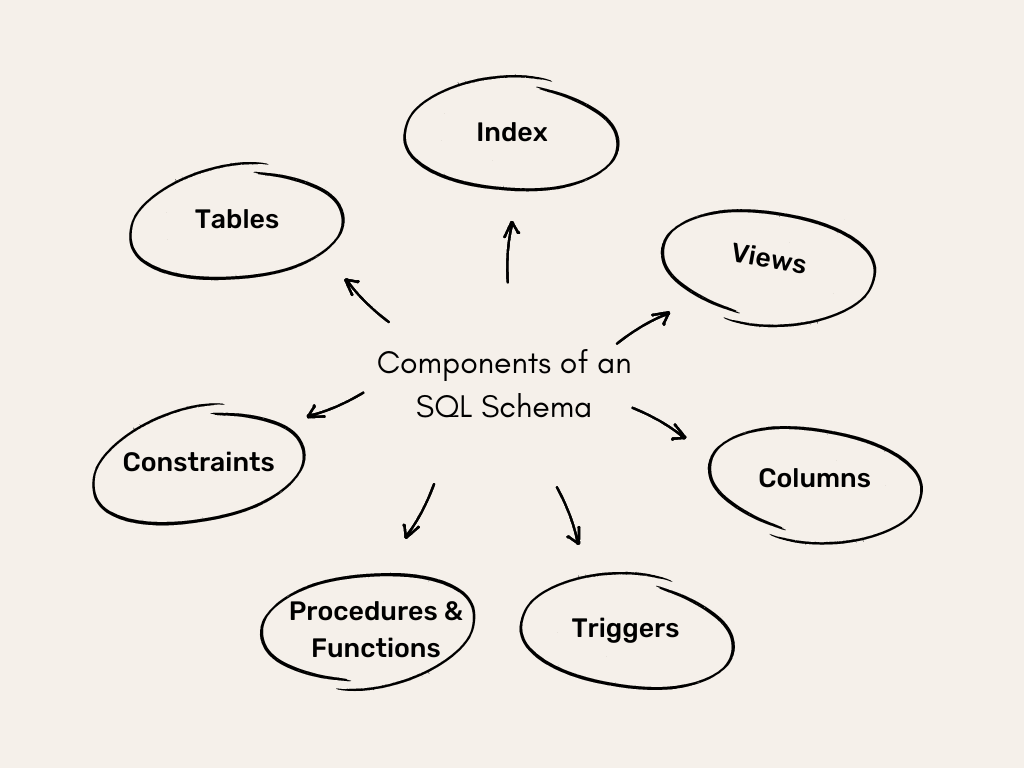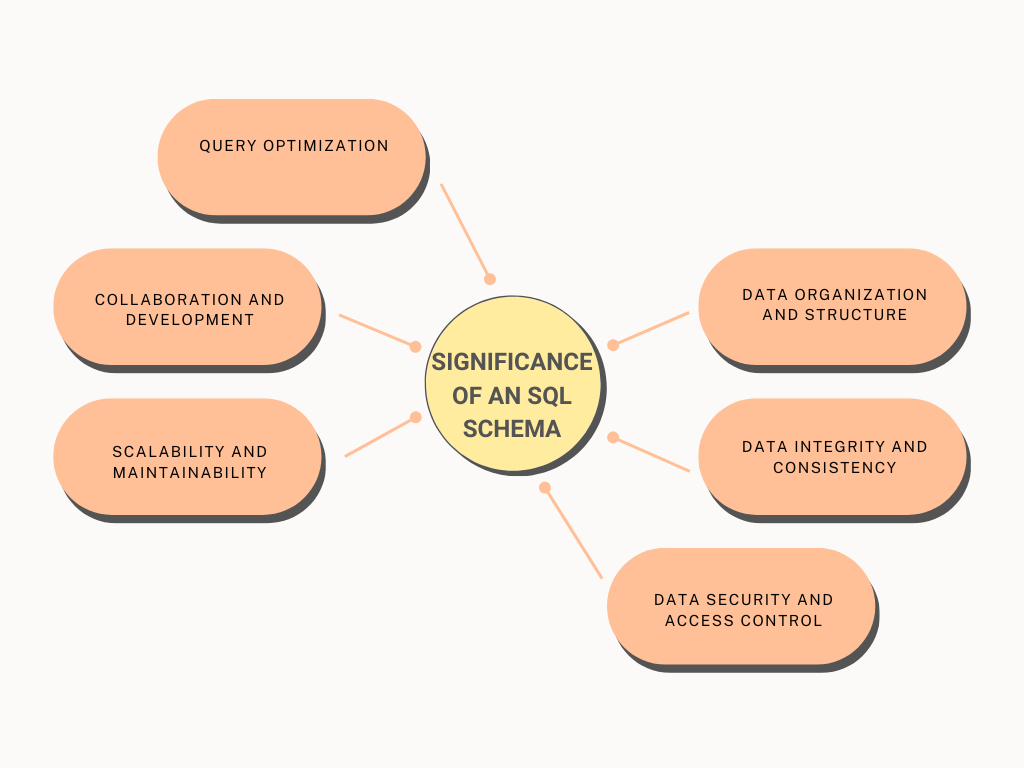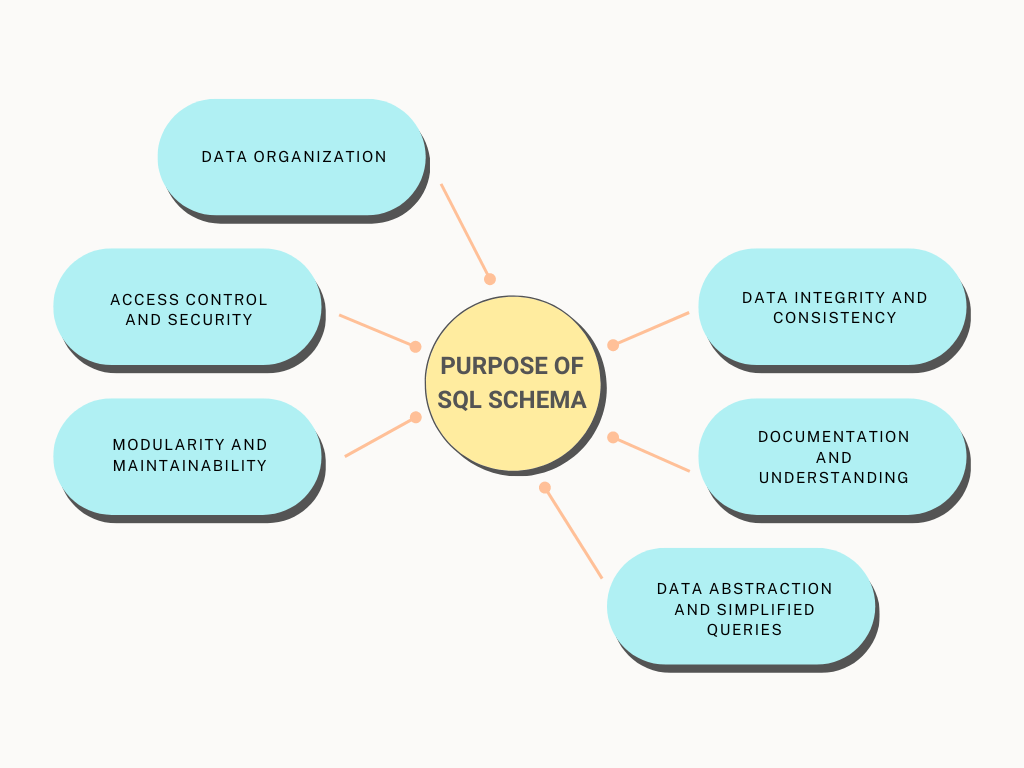SQL SchemaA SQL schema is a logical representation of a database, which means it is a logical container that keeps database objects such as tables, triggers, views, indexes, constraints, stored procedures, etc. It provides a way to arrange the database objects on the basis of their relationships and objectives. In this article, we will learn everything about SQL schema. Introduction:In SQL, a schema is a collection of database objects such as tables, stored procedures, indexes, views, and other entities that define the structure and organization of a database. It is essential to organize data for reliability, ease of use, and efficiency. SQL schema is the fundamental concept in database management that helps organize data objects and makes the data easier to manage and maintain. Components of an SQL Schema:
Tables are the central building block of a database schema. Tables hold data in a tabular form that consists of rows, also known as records, and columns, also known as fields. Tables describes the structure of the data stored within the database. Rows hold the actual data, and columns define the data types and constraints.
The index is the data structure associated with the table, which helps to retrieve data easily in less time; hence it speeds up the query execution, which is the main focus of the index. It can be created on one or more columns of a table to find specific data efficiently. It reduces the need to scan the entire data table and improves database performance.
Views are virtual tables that are virtual representations of data retrieved from tables in the schema. They act as stored SQL queries that can be used like normal tables. It simplifies complex queries, provides data abstraction, and restricts access to sensitive information.
Columns are part of the database table. It defines the type of data being stored in the table. Each column consists of a name, data type, and constraints that are optional such as uniqueness, nullability, and default value.
Triggers are an important component of the SQL schema. They are created to automatically execute before or after specific database events such as INSERT, DELETE, and UPDATE. It can be enabled and disabled depending on the specific requirements. It maintains data integrity and implements business logic.
Procedures and functions are stored programs that contain a series of SQL statements. Procedures are database objects that are stored permanently in the database and can execute a sequence of SQL statements as many times as desired. Functions are database objects that perform specific operations and return a single value on the basis of input parameters.
Constraints are business rules that allow data in a table to be appropriately maintained. It is applied to columns or tables to make sure that the data fulfills specific criteria. Common constraints are PRIMARY KEY constraints that allow each row in a table to be uniquely identified, FOREIGN KEY constraints that describe the relationship between two tables, NOT NULL constraints that make sure that no column contains a null value, CHECK constraints that make sure that data meets specific requirements, DEFAULT constraints that specify a default value for a column if no value is inserted, and UNIQUE constraints that make sure that all records in a table are unique. Significance of an SQL Schema:
Data organization and structure play an important role in efficiently storing, retrieving, and handling data within a database. An SQL schema provides a logical organization and structure to database objects such as tables, indexes, views, etc. Properly organizing the data in the database helps to navigate the data and understand the database structure easily.
SQL schemas allow us to define the structure of tables and to put constraints on tables like PRIMARY KEY, UNIQUE, FOREIGN KEY, etc. These constraints maintain data integrity. They help in preventing the insertion of invalid data, thereby improving the quality of the data.
They play an essential role in managing data security and access control within a database. The SQL schema provides authorized users with access to manipulate data, meaning it provides fine-grained control over who can view, modify, or execute specific database objects within the schema.
A properly organized schema provides scalability and maintainability of the database. A schema can be customized to support efficient data storage, retrieval, and manipulation. It provides easy management and performance optimization.
SQL Schema facilitates collaboration between developers and database administrators working on the same database. It allows the team to work on various aspects of the database simultaneously, which helps in improving productivity.
SQL schema plays an essential role in optimizing query performance. By structuring tables, proper indexing, and designing efficient views, database management systems can process queries more efficiently, which results in faster response times and improved overall database performance. Purpose of SQL Schema:
The primary purpose of SQL schema is to organize and structure the data within the database properly. Data can be organized in the database by defining relationships between tables, applying constraints on tables & columns, and setting rules for data integrity, hence providing data consistency.
The purpose of SQL schema is to provide data security. It helps manage access control and security within the database. It provides different levels of access privileges for different user roles by grouping objects under specific schema, which helps in enhancing security and saving sensitive data.
SQL Schema encourages modularity and maintainability in database design. It becomes easy to make changes or updates to specific sections of the database without affecting the entire system. It decreases the risk of errors and enhances overall maintenance and development efficiency.
SQL schema provides data integrity by defining constraints on tables and columns like primary key constraints, check constraints, foreign key constraints, etc. These constraints help maintain data consistency and prevent the insertion of invalid data.
A well-designed schema act as documentation for the database structure. It provides a clear representation of the relationships between tables, the purpose of each table, and the constraints applied. Schema documentation increases understanding, promotes knowledge sharing, and simplifies database maintenance and troubleshooting.
SQL schema allows data abstraction and simplifies complex queries. Views, which are virtual tables, provide a simplified and optimized view of the data, hiding unnecessary complexity and presenting the data in a format that is more interactive for users. Best practices for designing an effective SQL schema:
Before designing the SQL schema, properly understand the requirements of your system. Determine relationships between data entities.
Clear names make the schema easier to understand, so establish a consistent naming convention for database objects such as tables, columns, etc. It also improves collaboration among team members.
Normalization means breaking the data into smaller tables to avoid data duplication. You can apply normalization techniques to remove data redundancy and ensure data integrity. It helps to organize the data efficiently and enhance the performance.
Constraints are rules that are applied to tables or columns to prevent invalid or inconsistent data from being inserted into the database. You can use constraints, such as NOT NULL, PRIMARY KEY, UNIQUE, etc., which helps in providing data integrity.
Define suitable relationships such as one-to-one, one-to-many, and many-to-many between tables with the help of primary and foreign keys. Establishing relationships allows efficient data retrieval.
It is necessary to determine the security needs and access control mechanisms for the schema. You can define user roles and permissions to protect private data from unauthorized access.
Design the schema according to future needs keeping in mind the flexibility. You can use techniques like stored procedures, views, etc.
Documentation acts as a reference for administrators, developers, and future maintenance tasks, so it is important to document the schema design, such as its structure, relationships, etc.
Over time, requirements change, so it is important to regularly seek feedback from database administrators, stakeholders, and developers. It improves maintainability, optimizes performance, and adapts to new demands. Conclusion:In this article, you have understood SQL schema, which is a logical representation of a database that helps in organizing data objects like tables, stored procedures, indexes, views, etc. You have gained knowledge of components of SQL Schema such as tables, views, columns, constraints, triggers, etc. You have learned the significance of SQL schema, the purpose of SQL Schema, and how to design an effective SQL schema.
Next TopicSQL Queries for Practice
|
 For Videos Join Our Youtube Channel: Join Now
For Videos Join Our Youtube Channel: Join Now
Feedback
- Send your Feedback to [email protected]
Help Others, Please Share










